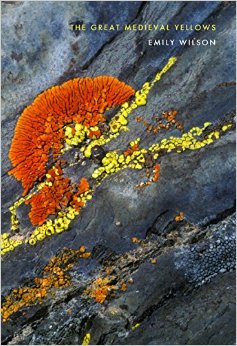What We’re Reading: The Great Medieval Yellows

 The Great Medieval Yellows by Emily Wilson (Canarium Books, 2015)
The Great Medieval Yellows by Emily Wilson (Canarium Books, 2015)
Emily Wilson is a poet focused on minutiae and the undersides of things. The cover of this book is a detail photograph of lichens growing on stones, which is an apt way to think about Wilson’s poems in The Great Medieval Yellows. The epigraph of the book, where the title comes from, refers to the yellow and gold pigments used in medieval painting. “The great medieval yellows,” likewise, are details from a larger work. Wilson’s poems hover over particulars, zooming in as far as possible until the thing itself is blurry and changed.
The major unit of lyric poetry is the line and Wilson uses the line to great effect, focusing the reader’s attention on words and phrases, blurring syntax, and generally confounding the senses. Here, the title poem is helpful to read. It begins:
Massicot mosaic gold
saffron buckthorn weld—
how to get your gilding on
it will not take part in
ruination of the blue.
The general lack of punctuation “welds” the phrases together until one is forced to try to break them up by looking at lines individually. In doing so, specks of color and light begin to emerge in an image that’s difficult to make out. “Eidolon” is operates in much the same way:
Ivory under-throats just
rust-violet
you can see
for the mean
interceptions, pinged, pierced
several stingers[…]
The sharp language here—“pierced,” “stingers,” etc.—hint at the precision of a microscope.
In Wilson’s previous collection, Micrographia (University of Iowa Press, 2009) includes the phrase “the little-boned / complex underthing,” which seems to be the subject of many of her poems. “Secretive Soil Fauna,” in The Great Medieval Yellows, focuses on fungi and parasites that live in root systems of plants:
of the fungi
I have done
apart no crime
can come
sintered slew
mite and nematode
For Wilson, the microscopic isn’t just a way of looking at something; sometimes it is the thing itself.
Sometimes, though, it’s not enough to scrutinize an image or object; Wilson is also adept at dissecting her medium: the English language. Using words that have changed meaning, or creating her own words, Wilson creates another sort of microcosm:
[…] just
how is it you
think you can
come in here and
scut the fatty mastics
off
the antagonies
the parsimonies
—“Secretive Soil Fauna”
Here, Wilson uses a late-Middle English verb-form of the word “scut,” meaning, “to shorten.” “Antagonies” and “parsimonies” Wilson created from the words “antagonist” and “parsimonious.” The heavy enjambments in Wilson’s poems force the reader to examine her diction searching for new meanings in these skittish lines.
In “Black Reaction” Wilson could be referring to herself when she writes,
what I’m scanning as
the sum of someone’s
scrupulous jitter-lines
tendered “from nature”
The effect of Wilson’s precision is an indistinct picture, often focused on images “tendered ‘from nature,’” that leaves the reader breathless and wondering. Her “jitter-lines” are like trying to look at something too close that just won’t snap into focus. In this way, Wilson’s voice is singular and kaleidoscopic, which is to say bright and shifting.
What other writers are stretching the uses of their language and phrasing?
Editor’s Note: This is the last (and fiftieth!) What We’re Reading review from our dear Timothy Otte, aka Chief Ampersand. Timothy is leaving his Hazel & Wren duties to further pursue and focus his own writing career. As an organization devoted to helping writers along their path, we feel that is the perfect reason to say goodbye. We will miss him terribly (as we’re sure you will, too), but we wish him all the very best writing, reading, and doing great things. You can follow him on the interwebs here: www.timothyotte.com. Timothy, thanks for being our very first believer in this adventure called Hazel & Wren. xoxo, Hazel & Wren





